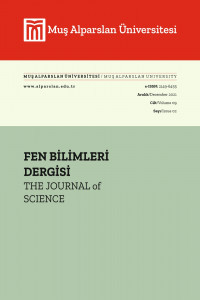Covid-19’un Lineer Hücresel Dönüşümler Yardımıyla Matematiksel Modellenmesi
Tüm dünyayı saran Covid-19 virüsü nedeniyle ülkeler zor günler geçirmektedir. İlk olarak Çin’in Wuhan kentinde ortaya çıkan bu virüs sonrasında hemen hemen tüm dünyaya yayılmıştır. Peki bu yayılma nasıl olmuştur? Bu virüsün hızla yayılmasındaki ülkelerin rolü nedir? Virüsün yayılmaması için insanlar üzerlerine düşen görevleri yerine getirmiş midir? Bu sorulara matematiksel bir bakış açısı ile cevap vermeye çalışalım. Bu çalışmada, virüsün yayılmasının nasıl olduğunu matematiksel olarak açıklanmaya çalışılmıştır. Matematiksel metot olarak iki boyutlu hücresel dönüşümler kullanılmıştır. Bu dönüşümlerin geçiş fonksiyonları yardımıyla yayılma durumları incelenmiştir. Böylece virüsün yayılma şeklinin matematiksel bir modeli çıkarılmış oldu. Bu noktada, her ne kadar devletler önlem alsada, kurallara uymayan insanların virüsü nasıl diğer insanlara aktardığının matematiksel olarak modellenmesi çalışıldı.
Anahtar Kelimeler:
Hücresel Dönüşüm, Temsili Matrisler, Covid-19, Sıfır Sınır Şartı.
Countries have a hard time due to the Covid-19 virus, which covers the whole world. This virus, which first appeared in Wuhan, China, has spread to almost the whole world. So how did this spread occur? What is the role of countries in the rapid spread of this virus? Have people fulfilled their duties to prevent the virus from spreading? Let's try to answer these questions with a mathematical perspective. In this study, it is tried to explain mathematically how the virus spread. Two dimensional cellular transformations were used as a mathematical method. The propagation states of these transformations were analyzed with the help of transition functions. Thus, a mathematical model of how the virus spreads was created. At this point, it was tried to model mathematically how people who do not obey the rules transfer the virus to other people, although the states take precautions.
___
- Von N.J. The theory of self-reproducing automata, (Edited by A.W.Burks), Univ. of Illinois Press, Urbana, 1966.
- Hedlund G.A. Endomorphisms and automorphisms of full shift dynamical system, Math. Syst. Theor. 3 320-375, 1969.
- Wolfram S. Statistical mechanics of cellular automata, Rev. Mod. Phys. 55:3 601-644,1983.
- Wolfram S., Packard N.H. Two dimensional cellular automata, Journal of Statistical Physics, 38 5-6, 1985.
- Khan A.R., Choudhury P.P., Dihidar K., Mitra S., Sarkar P. VLSI architecture of a cellular automata, Comput. Math. Applic. 33 79-94, 1997.
- Chattopadhyay P., Choudhury P.P., Dihidar K. Characterisation of a particular hybrid transformation of two-dimensional cellular automata. Computers Mathematics with Applications, 38:5-6 207-216, 1999.
- Holden A.V. Nonlinear Science- The Impact of Biology, Journal of the Franklin Institute 334:5-6 971-1014, 1997.
- Alvarez G., Encinas L.H., Martín del Rey A.A multisecret sharing scheme for color images based on cellular automata, Information Sciences, 178 4382-4395, 2008.
- Kokolakis I., Koukopoulos S., Andreadis I., Boutalis Y. Cellular automata-based noise generator, Journal of the Franklin Institute, 336:5 799-808, 1999.
- Wolfgang P. Quantum-dot Devices and Quantum-dot Cellular Automata, Journal of the Franklin Institute, 334:5-6 1147-1175, 1997.
- Ribba B., Alarcon T., Marron K., Maini P.K., Agur Z. The Use of Hybrid Cellular Automaton Models for Improving Cancer Therapy, ACRI 2004, LNCS 3305 444-453, 2004.
- Siap I., Akın H., Sah F. Garden of eden configurations for 2-D cellular automaton with rule 2460N, Inform. Sci. 180 3562-3571, 2010.
- Siap I., Akin H., Sah F. Characterization of two-dimensional cellular automata over ternary fields. Journal of the Franklin Institute, 348:7 1258-1275, 2011.
- Temiz F., Sah F., Akın H. Reversibility of a Family of 2D Cellular Automata Hybridized by Diamond and Cross Rules Over Finite Fields and an Application to Visual Cryptography, J. Cell. Autom. 14 241-262, 2019.
- Koroglu M.E., Siap I., Akın H. Error Correcting Codes via Reversible Cellular Automata Over Finite Fields, Arabian Journal for Science and Engineering (Springer Science and Business Media BV), 39:3 1881-1888, 2014.
- Koroglu M.E., Siap I., Akın H. The reversibility problem for a family of two-dimensional cellular automata, Turkish Journal of Mathematics, 40:3 665-678, 2016.
- Ying Z., Zhong Y., Pei-min D. On behavior of two-dimensional cellular automata with an exceptional rule”, Inform. Sci. 179 613-622, 2009.
- ISSN: 2147-7930
- Yayın Aralığı: Yılda 2 Sayı
- Başlangıç: 2013
- Yayıncı: Muş Alparslan Üniversitesi
Sayıdaki Diğer Makaleler
R3 de Açık B-Spline Eğrilerinin G-Benzerlikler
Abdullah ÖZKAN, Nilay ASKER, Vildan ÖZKAN
Plastik Film Malzemeler Üzerindeki Baskılarda Renk Farklılığına Neden Olan Etkenlerin Belirlenmesi
Gülhan ACAR BÜYÜKPEHLİVAN, Mehmet OKTAV
Covid-19’un Lineer Hücresel Dönüşümler Yardımıyla Matematiksel Modellenmesi
Yenilenebilir Kaynakların Mürekkep Üretiminde Kullanılabilirliğinin İncelenmesi
